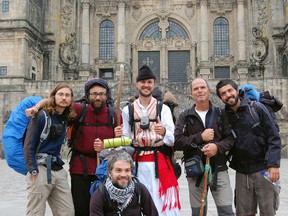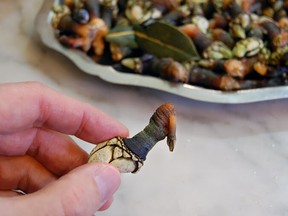Northwest space of Spain affords a distinct really feel, plus scrumptious meals, Rick Steves writes.

Critiques and suggestions are unbiased and merchandise are independently chosen. Postmedia could earn an affiliate fee from purchases made by way of hyperlinks on this web page.
Article content material
At any time when I’m in Santiago de Compostela, within the northwest nook of Spain, I’ve a three-part agenda: See pilgrims attain their aim in entrance of the cathedral, discover the market, and purchase some barnacles in its seafood part — then have them cooked for me, on the spot, in a café.
I make a degree to be in town sq. dealing with the towering Cathedral of St. James at round 11 within the morning. That’s when scores of well-worn pilgrims start gathering for the every day Pilgrim’s Mass, a triumphant celebration marking their completion of the Camino de Santiago (the Means of St. James) — a 500-mile hike from the French border.
Commercial 2
Article content material
Article content material
Because the Center Ages, humble hikers have walked these miles to pay homage to the stays of St. James in his namesake metropolis. Their conventional gear included a cloak; a sharp, floppy hat; a strolling stick; and a gourd (for ingesting from wells). The way in which is marked with yellow arrows or scallop shells (a logo of the saint) at each intersection. Doing the complete route from the border to Santiago takes about 4 to 6 weeks. I’ve by no means met a pilgrim who didn’t assume the trek was a life-changing expertise and properly well worth the sweat.
At journey’s finish, hikers full their pilgrimage by stepping on the steel scallop shell embedded within the pavement on the foot of the cathedral. I simply love watching how completely different pilgrims deal with the jubilation.
To face in entrance of the cathedral’s stately facade is the hiker’s dream. Routinely, pilgrims ask me to take their picture and electronic mail it to them. Then they are saying, “I’ve obtained to go meet with St. James,” and as has been the routine for hundreds of years, they head into the cathedral.
Santiago is a metropolis constructed of its native granite. Most individuals image Spain as a sizzling, arid land, however the Atlantic northwest of Spain enjoys much more precipitation than the inside (Spain’s northwest nook is house to a temperate rainforest, an hour north of Santiago). Rain off the Atlantic has coloured Santiago’s granite inexperienced with moss.
Article content material
Commercial 3
Article content material

Two blocks away from the cathedral, Santiago’s public market is flourishing, oblivious to the private triumphs occurring at St. James’ tomb. There’s one thing primary about wandering by way of a farmers market early within the morning anyplace on this planet: Salt-of-the-earth individuals pull meals out of the bottom, cart it into town, and promote what they’ve harvested to individuals who don’t have gardens.
Dried-apple grandmothers line up like a babushka cancan. Every sits on a stool so small it disappears below her work costume. On the girls’s toes are brown woven baskets stuffed as in the event that they had been cornucopias — still-dirty eggs in a single; within the subsequent, greens clearly pulled this morning, soil clinging to their roots. One lady hopes to earn a couple of additional euros with homebrews — golden bottles with ramshackle corks — one labeled licor café (espresso liquor), the opposite, orujo casero (do-it-yourself grappa).
I see rickety card tables stuffed with yellow cheeses formed like large Hershey’s Kisses…or, to locals, breasts. This native cheese is named tetilla to revenge a prudish priest who, seven centuries in the past, advised a sculptor on the cathedral to redo a statue that he thought-about too buxom. Ever since, the townsfolk have made their cheese precisely within the form the priest didn’t need seen carved in stone. You possibly can’t go anyplace in Santiago with out seeing its creamy, delicate tetilla.
Commercial 4
Article content material
Stepping farther into the market, I discover spicy pink chorizo — sausage in chains framing retailers’ faces. Chickens, plucked and searching as rubbery as might be, fill glass instances. Fisherwomen in rubber aprons and matching gloves type by way of folded cash.
There’s a commotion at one of the best stalls. Quick girls with dusty, blue-plaid curler carts jostle for one of the best offers. A collection of pigs’ ears combined with hooves going nowhere fills a shoebox. Neat rows of ears, translucent within the low rays of the morning solar, look as if somebody had systematically and neatly flattened a basket of conch shells.
From one vendor I purchase percebes (barnacles) at a 3rd the worth I’d pay in a bar. I get rather less than a half pound and hustle my bag over to the market café. There, Ramón and Julia boil them for a small payment. Feeling fairly like an area — sipping my beer so early within the morning — I eagerly await my barnacles to cook dinner.
Then comes the climax of my morning: Julia brings my barnacles, stacked steaming on a stainless-steel plate, in addition to bread and one other beer. I’m set. Twist, rip, chew. It’s the bounty of the ocean condensed into each little morsel…edible jubilation in Santiago.
This text is used with the permission of Rick Steves’ Europe (www.ricksteves.com). Rick Steves writes European guidebooks, hosts journey reveals on public TV and radio, and organizes European excursions.
Article content material
